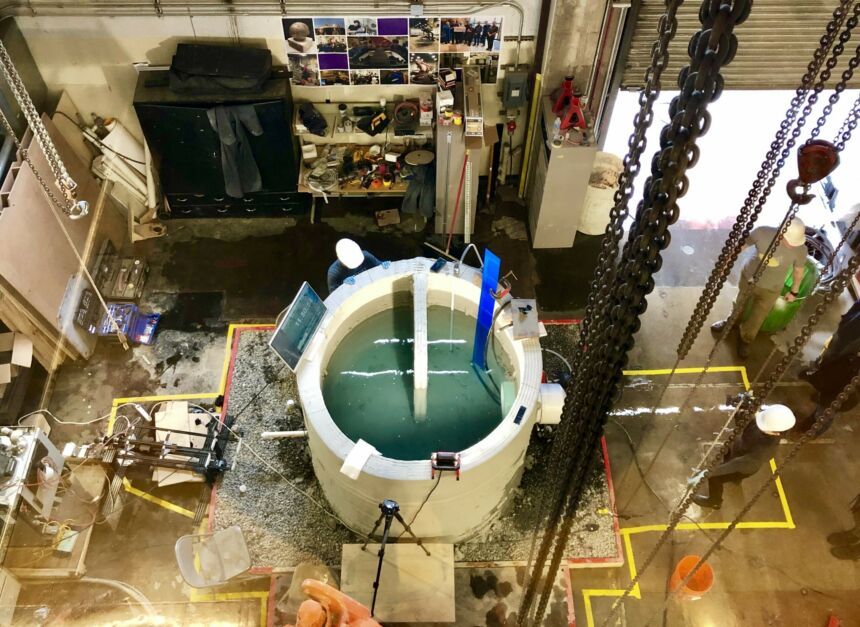February 05, 2019
Penn State NASA challenge team advances again, to be featured on Japanese TV

Update: The PennStateDen@Mars team placed third in the Phase 3: Construction Level 2 of the 3D-Printed Habitat Challenge and brought home a prize of nearly $84,000, as was announced Feb. 1 by NASA. For this level of the competition, six teams submitted 3D-printed samples that were tested for their ability to hold a seal, for strength and for durability in temperature extremes.
UNIVERSITY PARK, Pa. – NHK, Japan’s national public broadcasting organization, will be on the University Park campus tomorrow (Jan. 22) to film the Penn State interdisciplinary team that has advanced to the third phase of NASA’s $3.1-million 3D-Printed Habitat Challenge after successfully 3D printing a 2m wide by 1.8m tall water cistern.
The Phase 3: On-Site Habitat Competition boasts a grand prize of $500,000 for the winner of the head-to-head competition, to be held April 29 at Caterpillar Inc.’s Edward Demonstration and Learning Center in Peoria, Illinois.
The Penn State team, named PennStateDen@Mars, is led by Stuckeman School faculty members Shadi Nazarian, associate professor of architecture, and José Duarte, the Stuckeman Chair in Design Innovation and director of the Stuckeman Center for Design Computing. The team also includes Sven Bilén, professor of engineering design, electrical engineering, and aerospace engineering and head of the School of Engineering Design, Technology and Professional Programs (SEDTAPP); Aleksandra Radlińska, assistant professor of civil and environmental engineering; Ali Memari, Bernard and Henrietta Hankin Chair of Residential Construction (architectural engineering) and director of the Pennsylvania Housing Research Center; Nicholas Meisel, assistant professor of engineering design and mechanical engineering; and Randall Bock, assistant research professor of agricultural and biological engineering.
The NHK footage will appear in an upcoming episode of “Cosmic Front Next,” an astronomical documentary series that explores the topic of outer space and culture. The episode, which will air at 10 p.m. on March 28, will feature the NASA 3D-Printed Habitat Challenge, a Centennial Challenges Competition, which calls for inventors to design a human habitat that can be 3D-printed autonomously on Mars using indigenous or recycled materials.
According to the NASA website, the goal of the competition is “…to build a 3D-printed habitat for deep space exploration, including the agency’s journey to Mars. The multi-phase challenge is designed to advance the construction technology needed to create sustainable housing solutions for Earth and beyond.”
The PennStateDen@Mars team was previously awarded $150,000 for its second-place finish in the third level of Phase 2: Structural Member Competition and another $33,000 for its second-place finish in the foundation construction stage to get it through the final two phases of the competition.
While at Penn State, the NHK crew filmed the printing of a part designed by architecture student Drew Marshall in the course on “Design for 3D Printing in Concrete” to explore the suitability of concrete printing to make complex shapes.
The team would like to thank the host of Penn State students working on the project, including: Negar Ashrafi, Nate Watson, Andrew Przyjemski, Keunhyoung Park, John Piasente, Zhao Zhenyu, Naveen Muthumanickam, Sam Dzwill, Joe Straka, Aiden Smith, Kamrun Tithi and Flávio Craveiro, as well as to post-doctoral scholar Maryam Hojati and Digital Fabrication Technologies Coordinator Jamie Heilman. The team also thanks its sponsors, Autodesk, Gulf Concrete Technologies and Tilcon, along with the Penn State Materials Research Institute and Institutes of Energy and the Environment.
Originally published 1/21/2019
